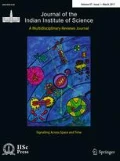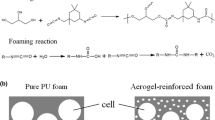Abstract
Negative Poisson’s ratio or auxetic foams were fabricated and studied for use in prosthetic applications. A thermomechanical process was used to convert conventional polyurethane (PU) foam into auxetic PU foam. Two types of auxetic PU foams were made using two different volumetric compression ratios, 3.02 and 3.86. Chemical composition analysis showed that chemical structure of the converted auxetic foam remained the same as the conventional PU foam after the thermomechanical process. Compression tests showed that the auxetic foams had higher stiffness than conventional foams, implying that the auxetic foams could be potentially used in seat cushions, shoe soles, and as liners in prosthetic applications. Compression fatigue tests showed that percentage loss in thickness in auxetic foam fabricated using lower compression ratio had loss in thickness that is comparable to conventional foam, whereas auxetic foam fabricated using higher compression ratio had greater loss in thickness. Our study indicates that the auxetic foams made using lower compression ratio need to be further explored for suitability in various rehabilitation applications.







Similar content being viewed by others
References
Bezazi A, Scarpa F (2007) Mechanical behaviour of conventional and negative Poisson’s ratio thermoplastic polyurethane foams under compressive cyclic loading. Int J Fatigue. https://doi.org/10.1016/j.ijfatigue.2006.07.015
Bezazi A, Scarpa F (2009) Tensile fatigue of conventional and negative Poisson’s ratio open cell PU foams. Int J Fatigue. https://doi.org/10.1016/j.ijfatigue.2008.05.005
Bianchi M, Scarpa F, Smith CW (2010) Shape memory behaviour in auxetic foams: mechanical properties. Acta Mater. https://doi.org/10.1016/j.actamat.2009.09.063
Chan N, Evans KE (1997) Fabrication methods for auxetic foams. J Mater Sci. https://doi.org/10.1023/A:1018606926094
Chan N, Evans KE (1998) Indentation resilience of conventional and auxetic foams. J Cell Plast. https://doi.org/10.1177/0021955X9803400304
Chekkal I, Bianchi M, Remillat V, Bécot FX, Jaouen L, Scarpa F (2010) Vibro-acoustic properties of auxetic open cell foam: model and experimental results. Acta Acust United Acust. https://doi.org/10.3813/AAA.918276
Cheng HC, Scarpa F, Panzera TH, Farrow I, Peng HX (2018) Shear stiffness and energy absorption of auxetic open cell foams as sandwich cores. Phys Status Solidi. https://doi.org/10.1002/pssb.200460386
Choi J, Lakes RS (1996) Fracture toughness of re-entrant foam materials with a negative poisson’s ratio: experiment and analysis. Int J Fracture. https://doi.org/10.1007/bf00036481
Duncan O, Foster L, Senior T, Allen T, Alderson A (2016) A comparison of novel and conventional fabrication methods for auxetic foams for sports safety applications. Procedia Eng. https://doi.org/10.1016/j.proeng.2016.06.323
Duncan O, Foster L, Senior T, Alderson A (2016) Quasi-static characterisation and impact testing of auxetic foam for sports safety applications. Smart Mater Struct. https://doi.org/10.1088/0964-1726/25/5/054014
Evans KE (1991) The design of doubly curved sandwich panels with honeycomb cores. Compos Struct. https://doi.org/10.1016/0263-8223(91)90064-6
Evans KE, Alderson A (2000) Auxetic materials: functional materials and structures from lateral thinking. Adv Mater. https://doi.org/10.1002/(SICI)1521-4095(200005)12:9%3c617:AID-ADMA617%3e3.0.CO;2-3
Fan D, Li M, Qiu J, Xing H, Jiang Z, Tang T (2018) A novel method for preparing auxetic foam from closed-cell polymer foam based on steam penetration and condensation (SPC) process. Appl Mater Interfaces. https://doi.org/10.1021/acsami.8b02332
Friis A, Lakes S, Park B (1988) Negative Poisson’s ratio polymeric and metallic foams. J Mater Sci. https://doi.org/10.1007/BF00551939
Grima N, Attard D, Gatt R, Cassar N (2009) A novel process for the manufacture of auxetic foams and for their re-conversion to conventional form. Adv Eng Mater. https://doi.org/10.1002/adem.200800388
Klute K, Glaister CB, Berge S (2010) Prosthetic liners for lower limb amputees: a review of the literature. Prosthet Orthot Int. https://doi.org/10.3109/03093641003645528
Lakes R (1987) Foam structures with a Negative Poisson’s ratio. Sci Rep. https://doi.org/10.1126/science.235.4792.1038
Lakes R (1991) Deformation mechanisms in negative Poisson’s Ratio materials: structural Aspects. J Mater Sci. https://doi.org/10.1007/BF01130170
Levy SW (1980) Skin problems of the leg amputee. Prosthet Orthot Int. https://doi.org/10.3109/03093648009103113
Li Y, Zeng C (2016) On the successful fabrication of auxetic polyurethane foams: materials requirement, processing strategy and conversion mechanism. Polymer. https://doi.org/10.1016/j.polymer.2016.01.076
Meulenbelt H, Geertzen J, Dijkstra P, Jonkman M (2006) Skin problems in lower limb amputees: an overview by case reports. Eur Acad Dermatol Venereol. https://doi.org/10.1111/j.1468-3083.2006.01936.x
Scarpa F, Ciffo LG, Yates JR (2003) Dynamic properties of high structural integrity auxetic open cell foam. Smart Mater Struct. https://doi.org/10.1088/0964-1726/13/1/006
Scarpa F, Pastorinol P, Garelli A, Patsias S, Ruzzene M (2005) Auxetic compliant flexible PU foams: static and dynamic properties. Phys Status Solidi. https://doi.org/10.1002/pssb.200460386
Scarpa F, Giacomin JA, Bezazi, A, Bullough, WA (2006) Dynamic behavior and damping capacity of auxetic foam pads. Proc. SPIE 6169, Smart Structures and Materials 2006: Damping and Isolation. https://doi.org/10.1117/12.658453
Smith W, Grima N, Evans E (2000) A novel mechanism for generating auxetic behaviour in reticulated foams: missing rib foam model. Acta Mater. https://doi.org/10.1016/S1359-6454(00)00269-X
Wang B, Zhang C, Zeng C, Kramer LD, Gillis A (2016) Prosthetic socket apparatus and systems. US 9486333, United States Patent and Trademark Office, 8 Nov 2016
Acknowledgements
The authors would like to acknowledge the assistance provided by Council of Scientific & Industrial Research, Government of India, in the form of CSIR Senior Research Fellowship.
Author information
Authors and Affiliations
Corresponding author
Additional information
Publisher's Note
Springer Nature remains neutral with regard to jurisdictional claims in published maps and institutional affiliations.
Rights and permissions
About this article
Cite this article
Chaithanya Vinay, V., Mohan Varma, D.S. Fabrication and Testing of Auxetic Foams for Rehabilitation Applications. J Indian Inst Sci 99, 511–518 (2019). https://doi.org/10.1007/s41745-019-00122-y
Received:
Accepted:
Published:
Issue Date:
DOI: https://doi.org/10.1007/s41745-019-00122-y




